The Next Generation Science Standards, or NGSS standards, are likely to start rolling out across the United States over the next few years. The first comprehensive overhaul in almost fifteen years, these standards outline new approaches to K-12 science education that blend content and practice, preparing students for success not only in STEM careers but across all modern workplaces. The guidelines build around the core idea that the methodologies of science (research, analytical thinking, communication) are as important as the content in preparing a student for navigating an increasingly complex, global world. High school students especially are meant to benefit from a practice-based education. The overall goal is for high school students to delve more deeply into each subject while learning real-life habits and skills used today by scientists and engineers.
Forty states have expressed interest in the measures, while 16 of them have already adopted them. For teachers in the fields of science and engineering, the new guidelines can feel overwhelming. Not only do the NGSS standards represent a radical shift in the overall approach to teaching science, but the guidelines themselves are also packed with information without providing a curriculum or lesson plan. So for educators and teachers looking to develop lesson plans for the NGSS, here are a few ways to start something.
First things first – we recommend starting with a Performance Expectation. Performance Expectations, or PEs, help educators measure what a student should know at the end of a particular topic. Each of the standards contained in the Next Generation Science Standards comes with a PE and can be found on the NGSS website. By starting with a PE, you can begin developing a series of lessons and activities that bridge expectation with the knowledge and skills students will already have in place at the beginning of instruction. This is important because the NGSS standards cover high school as a single grade band, so whether you teach 9th grade or 12th, you’ll have to adjust the lesson plan for their level of knowledge.
So now you have a Performance Expectation (the standard the student is meant to reach) and a grade level. We’ll look at a few example lesson plans from the 9th grade in a bit, but first, let’s continue looking at a bird’s-eye approach to developing your lesson plan. Then we’ll get more detailed with examples.
Once you’ve identified your Performance Expectation, read through the accompanying standards to find the competencies that will demonstrate how well students learned the related concepts and practices, and design assessments that give students an opportunity to demonstrate those competencies. Once you understand those benchmarks, you can begin to design activities to teach students the using the three dimensions.
It’s important to keep in mind that the Performance Expectation is not a learning objective, but rather, a series of goals that guide the activities and lessons you select. The lessons are meant to create learning experiences that will give students the confidence in demonstrating the expectations once it comes time for assessment. As a teacher, use the PEs to get creative on what kind of tasks and activities the students can do, so they can demonstrate their understanding of the PE with confidence.
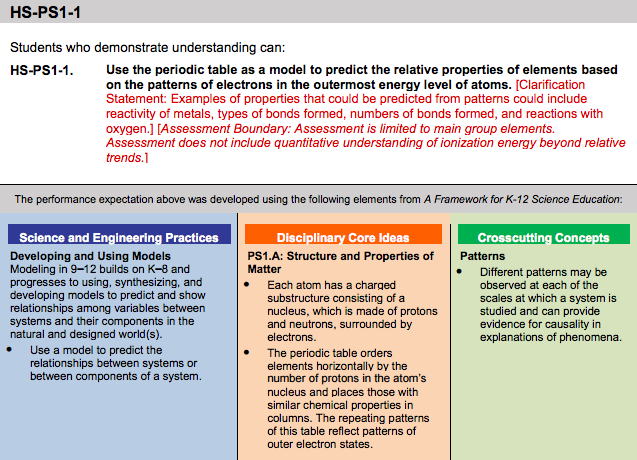
Let’s look at an example standard for the Physical Sciences at the high school level. The particular subject here is Matter and its Interactions. The Performance Expectation listed on the top reads: Use the periodic table as a model to predict the relative properties of elements based on the patterns of electrons in the outermost energy level of atoms.
Once you have the PE, take a look at the Disciplinary Core Idea, or DCI, that correspond to the Performance Expectation. The DCI is one of the three dimensions outlined in the Next Generation Science Standards. Using the DCI, brainstorm some ideas for phenomena: objects or events that scientists study in the world around them. Ideally the phenomena should be something interesting for the student to investigate and somehow related to their daily lives. A big emphasis of the new NGSS standards is showing students how science and engineering are all around us.
Once you have identified some useful phenomena, think about ways students can investigate and explore this phenomena. This piece is related to Science and Engineering Practices. What will the student have to do in order to demonstrate their understanding of this PE? Will students formulate questions to investigate, analyze data, or develop models? The NGSS offers some guidelines for this. In our example above for Physical Sciences, the Science and Engineering Practice associated with this PE is developing and using models. For each lesson, pick the science and engineering practice that will be used, and consider how the practice ladders up the student’s larger understanding of the PE.
Lastly, consider the final dimension in the NGSS standards, the Crosscutting Concepts. Which of the seven Cross Cutting Concepts is most relevant to the Performance Expectation? Just as you did with the Science and Engineering Practice, choose the Crosscutting Concept most related to the PE. Again, the NGSS offers recommendations for what this could be based on the subject. In the case of our example, the Cross Cutting Concept of patterns is called out.
Now, you have all the key elements outlined in the Next Generation Science Standards: the Performance Expectation and the three dimensions of practice, and the crosscutting and core ideas. Now you’re ready to write a Learning Performance, which is a single statement describing the objective of the lesson. The difference between this and the Performance Expectation is that the Learning Performance focuses on just one step in the instructional sequence.
At each step of the lesson sequence, you should be thinking about ways to incorporate the three dimensions into your lesson plans. The NGSS guidelines suggest asking yourself some questions. What are some commonly-held student ideas (both troublesome and helpful) about this topic? How could instruction build on them? What prior concepts do students need to learn to understand the core ideas? What level of abstraction is expected of them? What representations or media help students make sense of core ideas? What practices could students engage in to explore phenomena and representations of this concept? Are there crosscutting concepts that could support learning the core idea?
Another resource would be looking at the Common Core standards to find areas of overlap. This notion is fundamental to the success of the Next Generation Science Standards because the NGSS was developed with the belief that interconnecting previously disparate subjects give students a deeper and more meaningful engagement with what they are learning.
Digging Deeper: The Details of the Lesson Plan
When shaping the overall structure of your lesson plan, it’s helpful to consider a sequence of five different lesson types.
- Engage Lesson
- Exploration Lesson
- Explanation Lesson
- Elaboration Lesson
- Evaluation Lesson
The Next Generation Science Standards call this the 5-E Inquiry Model.
More information on this structure can be found in the National Research Council’s Guide to Implementing the Next Generation Science Standards, available for purchase online. But before you dive into the guide, let’s look at an example lesson plan that’s been developed by an independent educator in response to the NGSS standards.
Example Lesson Plan
Since the Next Generation Science Standards do not define a curriculum, states and local districts will have the responsibility for providing more detailed guidance to classroom teachers. So there is an additional measure of guidance that may come directly from your state or school district, but it’s helpful to take a look at some sample lesson plans that have already been developed and are available online.
In the example lesson below titled Chemical Reactions, we’ll see how the educator who developed this lesson incorporated the Performance Expectations, the three dimensions, and the 5-E Inquiry Model.
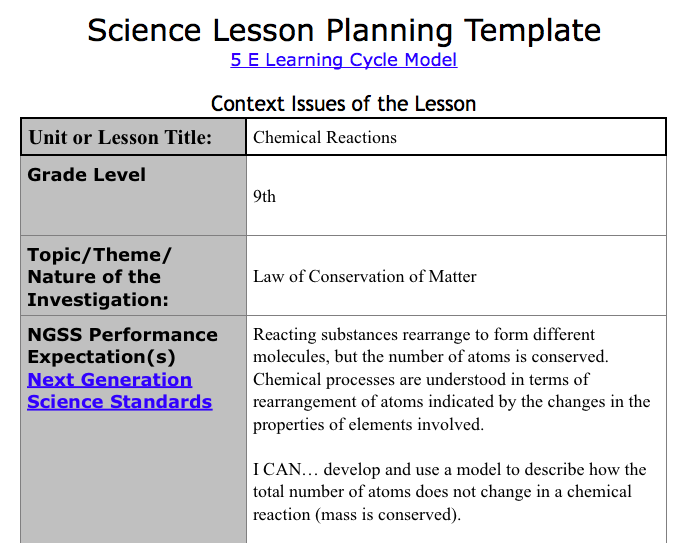
In this lesson plan, the educator has listed the topic/theme of the lesson as “Law of Conservation of Matter”. In this case, the educator has listed the Performance Expectation top, and directly following are the three dimensions. In this particular case, the educator hasn’t chosen specifics for each dimension, but lists them all out with a reminder to consider one or two while building the plan.
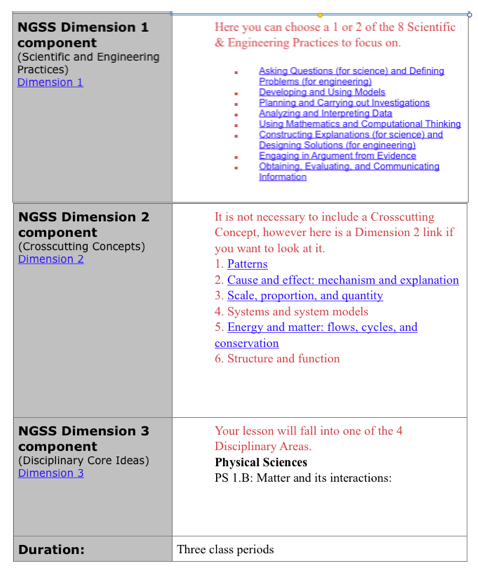
In this lesson plan, the educator has listed the topic/theme of the lesson as “Law of Conservation of Matter”. In this case, the educator has listed the Performance Expectation on top, and directly following are the three dimensions. In this particular case, they haven’t chosen specifics for each dimensions, but list them all out with a reminder to consider one or two while building the plan. You can also see that this educator plans on finishing this lesson after three class periods.
Finally, we start to see how they’ve worked through the 5-E Inquiry Model. Under each of the E’s (Engage, Exploration, Explanation, Elaboration, Evaluation) they have listed a purpose for the lesson and identified what the teacher is doing during the lesson as well as what the student is doing.
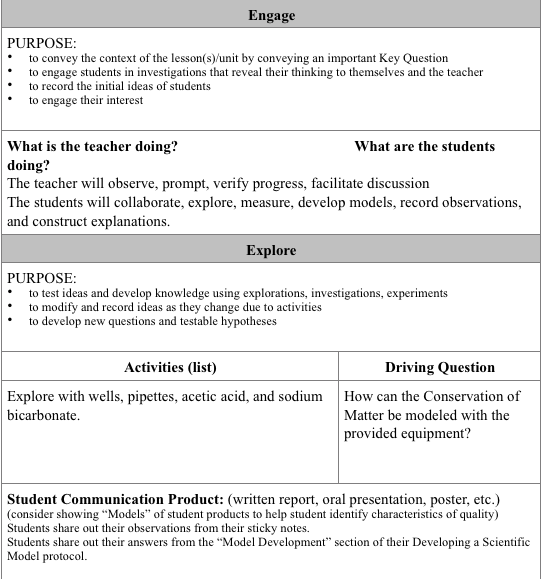
For example, under the Engage module for the Chemical Reactions lesson plan, the educator has listed their purpose as:
- to convey the context of the lesson by conveying an important Key Question
- to engage students in investigations that reveal their thinking to themselves and the teacher
- to record the initial ideas of students
- to engage their interest
During this module, the teacher will be to observe, prompt, verify progress, and facilitate discussion, while students will collaborate, explore, measure, develop models, record observations, and construct explanations.
The following module for Exploration builds on the previous lesson, as the notion of progressive learning is fundamental to the Next Generation Science Standards.
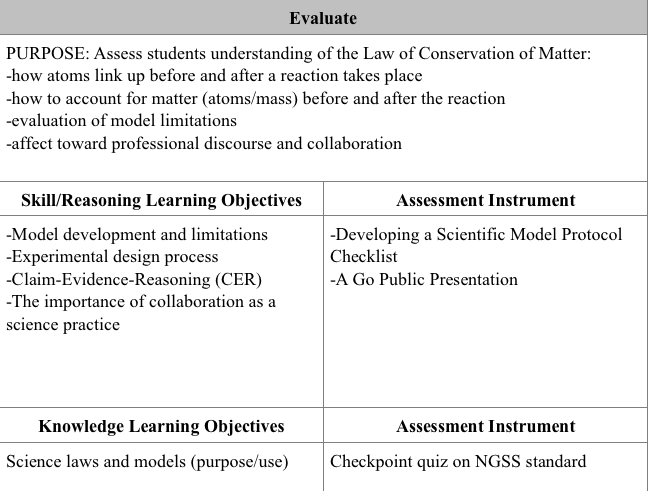
As the module progresses to the Evaluation stage, you begin to see the culmination of the lesson, and the educator’s plans for how to assess student knowledge on this topic. Note under the section titled Skill/Reasoning Learning Objectives, the educator has listed “the importance of collaboration as a science practice”. While this isn’t necessarily key to understanding chemical reactions, this does reflect the larger goals of the Next Generation Science Standards, which hopes to use science education to prepare students for life beyond school.
Let’s look at one more example of a sample lesson plan, this time for a Genetics and Probability instructional sequence for the 10th grade. In this example, you can see they’ve included the Performance Expectations and three dimensions directly from the NGSS standards themselves.
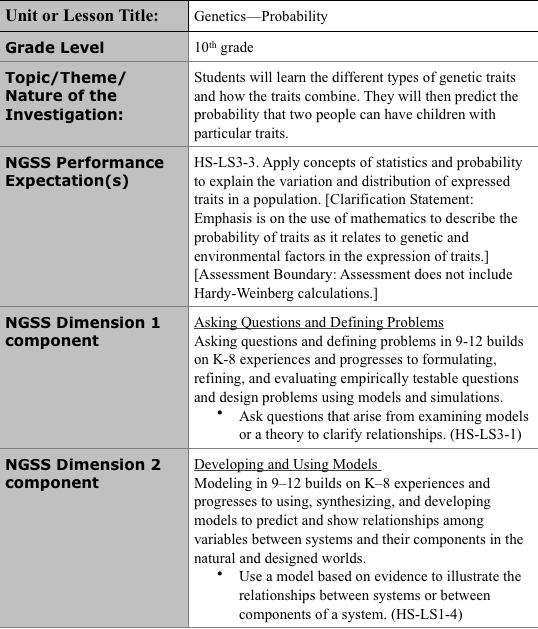
A fair amount of flexibility can go into the preparation of the lesson plan, which is on purpose. The developers of the Next Generation Science Standards intended to create a set of detailed guidelines but stopped short of creating specific lessons. So it will depend largely on your state, your school district and curriculum developers like you to begin implementing the NGSS in practice at your school.
In Summary: How to Write NGSS Lesson Plans
The best place to start when it comes to developing lesson plans that follow the Next Generation Science Standards is to familiarize yourself with the NGSS framework and the three dimensions. Then, take a look at the actual standards and how they are structured (and for a detailed account on how to read the standards, take a look at our article on it.
How does this differ from how you’ve created lesson plans in the past? Do you think the NGSS guidelines are helpful, or confusing? We’d love to hear from you! If you’d like to learn more about the committee that created the standards, check out our article on the minds behind the Next Generation Science Standards.
Looking for NGSS practice?
Kickstart your NGSS prep with Albert. Start your NGSS exam prep today.







